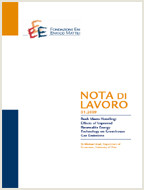The Economic Impact of the Green Certificate Market through the Macro Multiplier Approach

06.09.2010
Maurizio Ciaschini, Francesca Severini, Claudio Socci, Rosita Pretaroli
C67, E23, Q43, Q48
Environmental Policy, Hybrid I-O model, Macro Multiplier
Energy: Resources and Markets
Fausto Panunzi
In the last decade, as many other European countries, the Italian Government adopted several reforms in order to increase the use of Renewable Energy Sources (RES). The liberalization of the electricity market that represents one of these reforms aims to reach environmental benefits from the substitution of fossil fuel with renewable sources. The Italian Green Certificate market was introduced in 2002 in order to accomplish this objective and represents a mechanism where a quota of renewable electricity is imposed to suppliers in proportion to their sales. The electricity industries are obliged to meet this condition by producing the quantity of renewable electricity by means of a change in their production process, otherwise they must buy a number of certificates corresponding to the quota. This mechanism changes the importance of the electricity industry first in promoting climate protection, then in terms of the impact on the economy as a whole. A policy aimed to develop the market of green certificates may lead to environmental improvement by switching the energy production process to renewable resources. But above all an increase in demand for green certificates, resulting from a reform on the quota of renewable electricity, can generate positive change in all components of the industrial production. For this purpose, the paper aims to quantify the economic impact of a reform on Green Certificate market for the Italian system by means of the Macro Multiplier (MM) approach. The analysis is performed through the Hybrid Input-Output (I-O) model that allows expressing the energy ows in physical terms (GWh) while all other ows are expressed in monetary terms (€). Moreover, through the singular value decomposition of the inverse matrix of the model, which reveals the set of key structures of the exogenous change of final demand, we identify the appropriate key structure able to obtain both the expected positive total output change and the increase of electricity production from RES.
